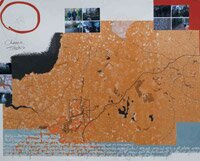This post was originally posted on this blog in 2011!
Interesting how much of it now relevant again…
The following passage was taken from
“DEEP MAPPING:” A brief Introduction by Iain Biggs.

The concerns of deep mapping in its visual and performing arts manifestations are best indicated by Clifford McLucas text There are ten things that I can say about these deep maps. For McLucas deep maps appear in the interaction between three basic elements: graphic or freestanding visual work; a time-based component film, video, performance, or music; and a database or archival system that remains open and unfinished. He sees the process of deep mapping as challenging our presupposition that knowledge is the specialist domain of professional experts and wants it to bring together “the amateur and the professional, the artist and the scientist, the official and the unofficial, the national and the local.McLucas also argues that deep maps should be a politicized, passionate, and partisan evocation of a site, involving negotiation and contestation over who and what is represented and how.Deep mappings should give rise to debate about the documentation and portrayal of people and places and be unstable, fragile, and temporaryconversations not statements. Mapping Spectral Traces 2010.
Clifford McLucas
my post from 2010
I am intending to rewrite my initial proposal in light of research I have done.
From a starting point of a ‘portfolio’ piece which showcased work using GPS and some form of app/website I have moved to a much more general approach drawing on the whole Deep Mapping idea. Indeed the closest fit to my initial aspirations of a ‘regional focus’ has been my recent discovery of the whole ‘deep mapping’ area.
I had already seen Patrick Keiller’s work and especially Robinson in Ruins which came out recently chimed with my own concerns. This has linked with the Pearson and McLucas definitions of Deep Mapping as a framework for proceeding. Indeed so much so that I am going to rewrite my initial proposal to acomodate this shift in focus. Although keen on social interaction and the kind of idea expounded in the ‘Context Providers’ book I am putting this on back burner until after M.A. completed and may form part of a larger package to take to Didcot Cornerstone Gallery (at present a gallery exposition is no longer a focus).
Deep Mapping is a complex idea and has complex outputs so the rest of this RPT M.A. is very much concerned with fitting the range of inputs into a manageable ‘online’ outcome as well as producing a range of discipline specific outcomes. I am no longer as focused on a specific app although it may still be produced.
I am also looking at merging google maps and a traditional website (which can be accessed through responsive or purposefully ‘mobilised’ websites).
To me the technology is simply a frame or container for the subject matter which is my main interest. Contemporary developments in hand held devices affords greater on location interaction but this does not now seem as important to me as providing a coherent interface for my wide ranging concerns.
It is a tall order to bring together my work in disparate fields and I am aware that there will be problems and that indeed the whole project may fall over through to many inputs but that is the most interesting aspect of this kind of work for me and also something I can honestly reflect upon as being genuine research in a fairly new area.
As Cliff McLucas stated
- “To investigate ways of dealing with landscape – in what the concept has come to stand for, in its permutations in various media (painting, photography, poetry, performance … ), in its disciplinary field of landscape studies (incorporating historical and cultural geography, art history, archaeology), in its association with contemporary notions of place and identity, in its implied cultural politicsâ€
and I also influenced by Mike Pearson’s definition
- †deep mapping……..takes region as its optic, acknowledging the effective ties between people and placeâ€.
To me this social, political and people-centered focus is at the heart of my enquiry.
Leave a Reply